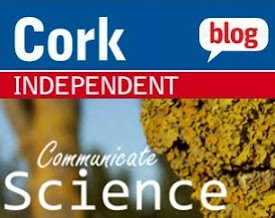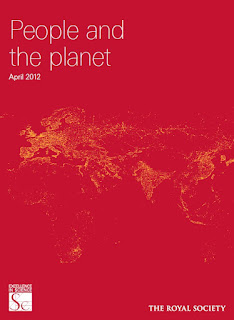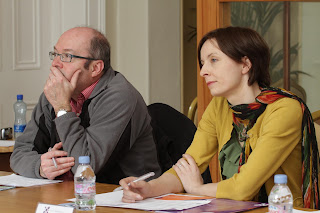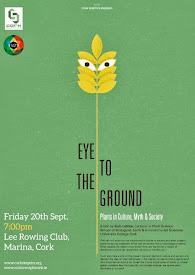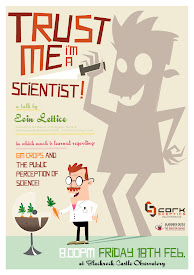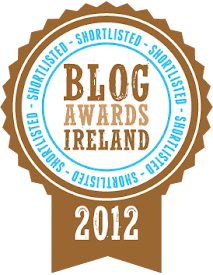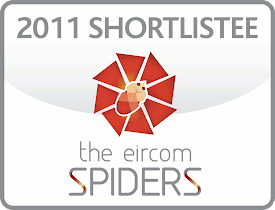Thursday, April 26, 2012
Friday, April 13, 2012
Science 140: Tweeting for #science
A new social media project coordinated by science bloggers Humphrey Jones (@thefrogblog) and Maria Daly (@maria_daly), the aim is to communicate science in an innovative way with contributors submitting their science definitions, biographies and explanations in 140 character snapshots.
After 24 hours online, the organisers say they have had hundreds of tweets offering explanations on everything from the definition of science to forces to aerodynamics to astronomy.
This project reminds me of a book I was given last Christmas called Tweeting the Universe by Marcus Chown (@Marcus Chown) and Govert Schilling. They tried to do a similar thing but with a narrower focus on astronomical topics (hence the title). Why is the sky blue? What is a black hole? etc.
They faced the challenge of converting what was a popular twitter stream into something that somebody would like to read in book form. A challenge, in my view at least, they didn't really deliver on.
Hopefully, with a broader remit, Science 140 will have more success when they release the curated results of the project in book form later in the year.
Speaking about the project, Humphrey Jones of Science 140 said “As a science teacher it’s always exciting to explore new ways of communicating science to young people and the general public. There is a very active science community on twitter and a project like Science 140 seems to be getting their attention. I think people love that their short contributions could be included in a book. We don’t want all the tweets to be too serious - science can be fun too".
You can find out more about Science 140 on the project website and on twitter @science140
Posted by Eoin Lettice at 6:02 PM 0 comments
Labels: Irish Science Blogs, scicomm, science communication, Science140, social media, twitter
Wednesday, April 11, 2012
Cobh: Titanic Connections and Ireland's First Female Pharmacist
 |
| Interior of Wilson's Pharmacy |
On this day 100 years ago, 123 passengers left Cobh (then Queenstown) in Co. Cork, Ireland to join the Titanic which was moored in Cork Harbour. So began the final journey across the Atlantic which was to end in disaster.
That tragedy has been marked across the globe this week as we approach the 100th anniversary of the ship's sinking.
Earlier in the week, Communicate Science took a visit to Cobh to mark the anniversary. We visited the new Titanic Experience housed in the former White Star Line offices - the very building the Titanic passengers would have walked through and viewed the original White Star pier - badly in need of repair.
If you visit Cobh, Titanic Experience is worth a visit. It is just that; a real experience of life on board and the tragedy that occurred. If you're into the more detailed nitty-gritty of the tragedy, a visit to the nearby Cobh Heritage Centre is highly recommended.
 |
| White Star Pier, Cobh |
Just along the seafront from the Titanic memorial is Wilson's Pharmacy, which has been serving the people of Queenstown, Cobh and the visiting ships for over 100 years.
Opened in 1908 by John and Christina Wilson, it is remarkable that Christina Wilson was the first female pharmacist in Ireland.
 Christina (nee Jessop) was born in Dublin in 1879, trained in Furlong's Chemist and was the first female pharmacist to qualify in Ireland in 1900. She went on to work in the South Dublin Union (now Saint James' Hospital) and it was there she met a young pharmacist from Cork who she married.
Christina (nee Jessop) was born in Dublin in 1879, trained in Furlong's Chemist and was the first female pharmacist to qualify in Ireland in 1900. She went on to work in the South Dublin Union (now Saint James' Hospital) and it was there she met a young pharmacist from Cork who she married. The couple returned to John's native Cobh and set up the family pharmacy at 18 West Beach. Three of their children, Jasper, John and Maura became pharmacists.
The pharmacy is now owned by Therese Wilson, granddaughter of the original owners.
The shop supplied ships of the White Star Line and, most likely, passengers aboard the Titanic. Much of the original shop fittings are still in place. As a piece of scientific heritage, it's a real find. Its connection with Ireland's first female pharmacist makes it even more impressive.
Posted by Eoin Lettice at 11:11 PM 0 comments
Labels: Cobh, Cork, heritage, history of science, Ireland, pharmacy, Titanic, Women in science
Tuesday, April 10, 2012
The plants and trees of Fota
Fota Island was originally the home of the Smith-Barry family and in the ownership of that family since 1177. After the death of the last of the Smith-Barrys in 1975, the Island was sold to University College Cork. Over time, parts of the island has been put to a variety of uses including the unique Fota Wildlife Park. Although financial constraints required parts of the estate to be sold off for a golf course and hotel development, much of Fota remains in public ownership.
Fota House, former seat of the Smith-Barrys and their impressive gardens and arboretum is open to the public and is well worth a visit.
The Irish Heritage Trust took over responsibility for Fota House, Arboretum and Gardens in 2007 and there has been some noticeable improvements in signage and accessibility in that time. The Office of Public Works manage the gardens and arboretum.
Many sources describe the word Fota as coming from the Irish term 'Fód te' meaning warm soil and as such, the gardens are a great spot to relax and enjoy one of the greatest collection of rare and tender trees and shrubs growing outdoors in Ireland and Britain.
 |
| Japanese Cedar - a billowing thundercloud |
The Smith-Barrys can be credited with the laying-out of the gardens and arboretum. Even up to the last of the Smith-Barrys, a Mrs. Bell, cataloguing and conserving the plant collections were important.
 |
| Japanese Cedar |
There are a few small Monkey Puzzle (Araucaria araucana) trees in the arboretum.
 |
| Monkey Puzzle (Araucaria araucana) |
Now is also a good time to visit. The Camellia and Magnolia are already in flower and Primroses abound in the wooded areas.
 |
| Magnolia 'Big Dude' |
 |
| Camellia japonica 'Lavinia Maggi' |
There is a magnificent Drimys winteri 'Glauca' currently in flower. Native to rain forests of Chile and Argentina, the bark of the plant known as "Winter's Bark" was a well known cure for scurvy.
 |
| Drimys winteri 'Glauca' |
 |
| Drimys winteri 'Glauca' |
For those who love plants Fota is a must visit. Understandably, the animals in the nearby wildlife park are a huge draw but, and at the risk of spoiling this oasis of calm, the gardens and arboretum deserve to be more visited in their own right.
Fota Garden and Arboretum are open year round and entry is free. There is however a €3 charge for parking. The island can also be accessed by train from Cork's Kent railway station. Charges apply for visiting Fota House and Fota Wildlife Park.
The Fota House Plant and Garden Fair takes place on Sunday 22nd April 2012 in association with Marymount Hospice New Building Fund. For more details, see www.fotahouse.com
Posted by Eoin Lettice at 12:00 AM 1 comments
Labels: arboretum, botany, Cork, Fota, plant science, plants, trees
Wednesday, April 4, 2012
Cutbacks in Science Subjects at Second Level
According to an ASTI survey published today (conducted by Millward Brown):
- 47% of schools surveyed (151 took part in the research) had dropped one or more subjects at Leaving Cert level since 2009.
- Of those schools which dropped subjects, 23% dropped Accounting, another 23% dropped Economics.
- 21% of schools have stopped teaching Physics at Senior Cycle level.
- 15% have stopped teaching Applied Maths.
- 11% have stopped teaching Chemistry.
- 32% of schools report significant levels of overcrowding in Biology classes at Leaving Cert level.
- 48% of schools say they will drop one or more subjects at Junior Cycle in 2012.
- 64% say they will drop one or more subjects at Senior Cycle.
- The top three subjects to be dropped? Accounting, Chemistry, Physics.
At a time when we are trying to promote the study of science at 2nd and 3rd level, funding cuts are making it more likely that students will attend a school where they will not be able to study all of the sciences. While Biology remains available to most students (although increasingly in overcrowded classrooms and labs), it is only because of its relative popularity when compared to Phyisics and Chemistry.
According to figures released by the State Examinations Commission, 30,349 students took Biology Leaving Cert exams (at either level) in 2011. This compares to 7677 for Chemistry and 6516 for Physics.
While cutbacks in funding are undoubtedly part of the equation, the popularity of these subjects is also relevant. If 30,000+ students were studying chemistry and physics they might not have been dropped as readily. We need to do more to make science in general an appealing subject choice at 2nd level and certainly, cutting availability of the subject is not the way to go.
The survey doesn't go into it, but it would be interesting to see the gender breakdown. Are chemistry and physics being dropped across the board or are they more likely to be dropped in girls-only schools? It would be interesting to find out.
Has your school dropped science subjects? Let us know by adding a comment below
Posted by Eoin Lettice at 1:09 PM 1 comments
Labels: budget, education, education policy, leaving cert, schools, scicomm, science policy, STEM
The Case of the Vanishing Narwhal
Narwhals (Monodon monoceros) are normally found in Arctic waters and, if confirmed, this will be the first recorded stranding of such a creature in Ireland. The thing is, it can't be confirmed, because the body of the dead cetacean has been removed in mysterious circumstances.
I can remember the first time I saw a Narwhal in either the Paris or Berlin Natural History Museum (I can't remember which) and being amazed that such a creature existed. For me, it falls into the same category as the duck-billed platypus, i.e. someone's having a laugh and clearly just stuck a fake tusk on a dolphin. But no, these creatures are perfectly real and their strange appearance has led to them being the source of some confusion over the centuries. Medieval Europeans, when presented with the excised tusks, believed them to be horns from the mythical unicorn.
The IWDG say that Max Halliday spotted the stranded corpse near the Rock shop in Liscannor, Co. Clare (incidentally, that's the birthplace of one John Philip Holland, the Irishman who invented the submarine) on Sunday, March 25th. He reported the strange find to the IWDG on Monday 26th but the message wasn't picked up until Friday the 30th.
By the time IWDG and GMIT researchers were on site, the carcass was missing and all that remained was a grease stain and a lingering smell of rotting cetacean.
According to the IWDG, Max's description is as follows: "a cetacean that was larger than a dolphin at c15ft, with no dorsal fin, but most interestingly with a spiral tusk, about the length of a hurley, protruding from its head".
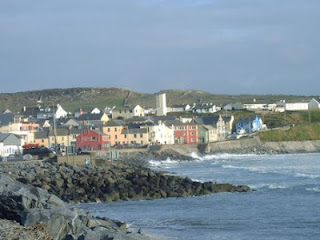 |
| Liscannor, Co. Clare |
Researchers were able to take small tissue samples from the site of the stranding which should be able to confirm if it was indeed a narwhal but they are keen to locate the corpse, not only to identify it, but to ensure it's preserved for posterity at the Natural History Museum.
"If we can prove this, then this is a very important finding, as this is a first for Ireland, bringing to 25 the number of cetacean species recorded in our waters", said Pádraig Whooley of the IWDG.
The group have appealed to people living in Co. Clare who may have seen the animal before it was removed to contact them with their observations and photos. They have also reminded those who removed the corpse that "all cetaceans in Irish waters, dead or alive, are fully protected by Irish law, and a special licence is required from NPWS for anyone in possession of such an animal or parts of".
"This is a potentially significant extralimital record of an Arctic vagrant, which to the best of our knowledge has never previously been recorded this far south."
"Clearly we are disappointed that thus far this animal has produced no photographic evidence which would be a far simpler way of confirming species ID, as male Narwhals are the only cetaceans that exhibit such a tusk, which is actually a protruding tooth on the upper jaw. So this is a public request for assistance and once again is not a 1st of April prank."
Update 05/04/2012: Clare County Council have said that they removed a carcass from Liscannor beach on the 27th March due to public health concerns and it is now destroyed. The contactors who carried out the removal did not report any tusk but that the corpse had already been significantly decomposed at that stage. Perhaps the eyewitness was mistaken is seeing a tusk? Perhaps the tusk was removed prior to the council moving the animal? Looks like this mystery will only be solved when the results of the genetic analysis are known. Stay tuned!
If you saw the creature and/or took photographs of same, you can contact the IWDG on [email protected]
RTE News have reported on the mystery:
Posted by Eoin Lettice at 9:46 AM 0 comments
Labels: Cetacean, Ireland, IWDG, marine, Narwhal, Natural History
Tuesday, April 3, 2012
Debating Science
This is the only All-Ireland collaborative science outreach initiative of its kind. A field of forty schools narrowed to just four through preliminary debate rounds on a variety of contemporary biomedical science topics.
The four secondary schools in the final will be: St. Catherine’s Vocational School, Killybegs, Donegal; Clonakilty Community College, Cork; St. Andrews College, Blackrock and Abbey Vocational School, Donegal Town.
The first two debates, St. Catherine’s Vocational School against St. Andrews College and Abbey Vocational School against Clonakilty Community College, will focus on the moral obligation to explore research with embryonic stem cells due to the potential to develop new medical treatments. The winners of those rounds will then meet to debate the necessity of animal testing for advancing disease treatment.
Debating Science Issues encourages young people to engage in debate on the cultural, societal and ethical implications of advances in biomedical science. The competition is led by REMEDI at NUI Galway and collaborators include APC at UCC, BDI at DCU, RCSI, CIT, CRANN at Trinity College, W5 in Belfast, Clarity at UCD and The Centre for Cross Border Studies in Armagh.
Danielle Nicholson, All-Ireland Co-ordinator of Debating Science Issues (DSI), said “This cross border project provides a great opportunity for the teachers and students to be exposed to some of the latest developments in biomedical research and also to consider the ethical elements which can be a great hook to interest young people in the science.”
Data collected from five cycles of DSI involving more than 3500 students shows an increase in interest in science as a subject and as a career as a result of participation in the project. This schools’ biomedical science workshop series and debate competition has been supported by the Wellcome Trust for five consecutive years. Provincial trophies and prizes are provided by Abbott Ireland, Boston Scientific, Merck- Millipore and Pfizer Ireland.
Every year the project has evolved and has responded to the feedback gathered continuously throughout the project. This year a new Topic Guide on rare diseases was introduced and a dedicated website has been developed, www.debatingscienceissues.com
Posted by Eoin Lettice at 9:49 AM 1 comments
Labels: Debating Science, scicomm, science communication
PAGES
Popular Posts
It's just a little bit of science!
I'm a plant scientist, so expect lots of plant-related posts but also lots on science in general and science communication.
Enjoy!
Contact: [email protected]
All content, unless otherwise stated, is copyright of Communicate Science and should not be used without prior consent.
Opinions expressed on this blog represent my own views and not those of my employer. Any comments on posts represent the opinions of visitors.
Wade through the scrivenery
Subscribe for Free
Tweet, Tweet

This is me

- Eoin Lettice
- I'm passionate about the need to enthuse, inform and engage everyone in society about science. I'm a full-time researcher and lecturer and a part-time blogger. I'm interested in all things to do with science. In particular, education and communication of science - especially biology. This blog represents my personal views.
